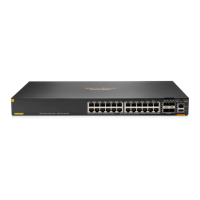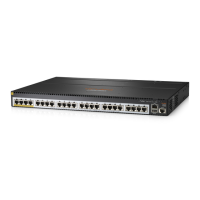84
Configuring DHCP snooping
About DHCP snooping
DHCP snooping is a security feature for DHCP.
DHCP snooping works between the DHCP client and server, or between the DHCP client and DHCP
relay agent. It guarantees that DHCP clients obtain IP addresses from authorized DHCP servers.
Also, it records IP-to-MAC bindings of DHCP clients (called DHCP snooping entries) for security
purposes.
DHCP snooping defines trusted and untrusted ports to make sure clients obtain IP addresses only
from authorized DHCP servers.
• Trusted—A trusted port can forward DHCP messages correctly to make sure the clients get IP
addresses from authorized DHCP servers.
• Untrusted—An untrusted port discards received DHCP-ACK and DHCP-OFFER messages to
prevent unauthorized servers from assigning IP addresses.
DHCP snooping reads DHCP-ACK messages received from trusted ports and DHCP-REQUEST
messages to create DHCP snooping entries. A DHCP snooping entry includes the MAC and IP
addresses of a client, the port that connects to the DHCP client, and the VLAN.
The following features need to use DHCP snooping entries:
• ARP attack detection—Uses DHCP snooping entries to filter ARP packets from unauthorized
clients. For more information, see Security Configuration Guide
.
• MAC-forced forwarding (MFF)—Auto-mode MFF performs the following tasks:
{ Intercepts ARP requests from clients.
{ Uses DHCP snooping entries to find the gateway address.
{ Returns the gateway MAC address to the clients.
This feature forces the client to send all traffic to the gateway so that the gateway can monitor
client traffic to prevent malicious attacks among clients. For more information, see Security
Configuration Guide.
• IP source guard—Uses DHCP snooping entries to filter illegal packets on a per-port basis. For
more information, see Security Configuration Guide.
• VLAN mapping—Uses DHCP snooping entries to replace service provider VLAN in packets
with customer VLAN before sending the packets to clients. For more information, see Layer
2—LAN Switching Configuration Guide.
Application of trusted and untrusted ports
Configure ports facing the DHCP server as trusted ports, and configure other ports as untrusted
ports.
As shown in Figure 29, co
nfigure the DHCP snooping device's port that is connected to the DHCP
server as a trusted port. The trusted port forwards response messages from the DHCP server to the
client. The untrusted port connected to the unauthorized DHCP server discards incoming DHCP
response messages.

